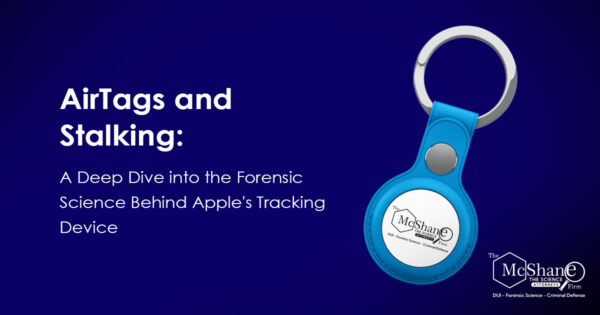Introduction

AirTags, Apple’s compact and user-friendly tracking devices, have taken the world by storm since their release. Designed to help users locate misplaced items, AirTags use Bluetooth and the vast Find My network to pinpoint the location of lost belongings. However, their tracking capabilities have also sparked concerns about their potential misuse for stalking purposes. In this highly technical forensic science blog post, we will delve into the inner workings of AirTags and explore the potential risks and countermeasures associated with stalking.
How AirTags Work
AirTags employ a combination of technologies to provide accurate location tracking. Each AirTag contains an Apple-designed U1 chip that uses Ultra-Wideband (UWB) technology, enabling precise distance and direction measurements between devices. Additionally, AirTags communicate with nearby iPhones, iPads, and Macs via Bluetooth to relay their location data to the owner through the Find My network.

When an AirTag is within Bluetooth range of its owner’s device, the Find My app displays the tag’s location on a map, allowing the owner to play a sound or use Precision Finding (available on devices with U1 chips) to locate the item. If the AirTag is out of range, its location is updated using the Find My network, which relies on the encrypted communication of millions of Apple devices worldwide.
AirTags and Stalking Risks
The AirTag’s precise tracking capabilities have raised concerns about potential misuse for stalking or other malicious purposes. A stalker could secretly attach an AirTag to a person’s belongings or vehicle to monitor their movements. Since AirTags are small and discreet, detecting their presence could be difficult.
Apple’s Anti-Stalking Measures
To mitigate the risks associated with unwanted tracking, Apple has implemented several anti-stalking features:
- Unwanted Tag Detection: If an unknown AirTag is detected traveling with an iPhone user for an extended period, the user will receive a notification, alerting them of the potential stalking threat.
- Audible Alerts: If an AirTag has been separated from its owner for a certain period, it will emit an audible sound, drawing attention to its presence.
- Privacy Measures: AirTag location data is end-to-end encrypted and not accessible by Apple. Moreover, location data is not stored on the AirTag itself.
- NFC Capability: Android users can tap an AirTag with their NFC-enabled smartphone to access information about the tag and disable it if necessary.
Limitations and Future Developments
While Apple’s anti-stalking measures offer some protection, they are not foolproof. Stalkers could attempt to bypass these safeguards by using multiple AirTags or hacking the devices to disable their safety features. Researchers and Apple are continuously working to identify potential vulnerabilities and develop more robust countermeasures against stalking.
Conclusion
AirTags have revolutionized the way we keep track of our belongings, but they also present new challenges in terms of privacy and security. By understanding the forensic science behind AirTags and staying informed about potential risks and countermeasures, we can ensure that this innovative technology is used responsibly and safely.


